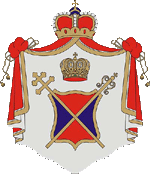Montenegrin Orthodox Church
| Montenegrin Orthodox Church Црногорска православна црква Crnogorska pravoslavna crkva |
|
|---|---|

Coat of arms of the Montenegrin Orthodox Church
|
|
| Founder | Metropolitan Antonije |
| Independence | 1993. |
| Recognition | Bulgarian Orthodox Church – Alternative synod, Orthodox Church in Italy, Georgian Orthodox Church, Moldovan Orthodox Church Ukrainian Orthodox Church |
| Primate | Metropolitan Mihailo |
| Headquarters | Cetinje |
| Territory |
|
| Possessions | None |
| Language | Montenegrin |
| Members | Approximately 10,000 |
| Website | www.cpc.org.me |
The Montenegrin Orthodox Church (MOC, Montenegrin: Црногорска православна црква, ЦПЦ / Crnogorska Pravoslavna Crkva, CPC) is an Orthodox Christian Church acting in Montenegro and Montenegrin diaspora (most notably in Serbia and Argentina). It was created in 1993 claiming succession to the Montenegrin Church which operated until the annexation of Kingdom of Montenegro into the Kingdom of Yugoslavia in 1918, and recognized as a religious community by the Government of Montenegro in 1999. However, it remains canonically unrecognized by other Orthodox Churches and claims over the canonical jurisdiction of the Serbian Orthodox Church, most notably its Metropolitanate of Montenegro and the Littoral.
In a 2009 poll conducted by CEDEM, 29.36% of Montenegro's Eastern Orthodox Christians have since opted for the Montenegrin Orthodox Church, while 70.64% opted or stayed with the Serbian Orthodox Church.
MOC considers itself to be the sole legitimate representative of Orthodox Christianity in Montenegro, and also lay claim to all Orthodox Christian property in Montenegro that is currently in the possession of the Serbian Orthodox Church. From time to time, MOC members and supporters have attempted to claim some of these structures (mostly in the Cetinje municipal area).
The Montenegrin Orthodox Church was founded in Cetinje on October 31, 1993, by Antonije Abramović, allegedly with the Liberal Alliance of Montenegro (LSCG), a political party that existed at the time. At the time, Montenegro was part of the federal state with Serbia called the Federal Republic of Yugoslavia, which was formed a year earlier following a 1992 referendum. LSCG, a party with a pro-independence agenda, is claimed to having used MOC as a tool in their quest for Montenegrin sovereignty. At that time, the ruling Democratic Party of Socialists of Montenegro (DPS) maintained close ties to Milošević's administration in Serbia, and therefore the initial activities of the MOC were very sporadic. By 1997, the DPS administration in Montenegro led by Milo Đukanović began to distance itself from Milošević, and MOC was registered as a civic group. By this time, LSCG had distanced itself from MOC almost completely. On January 17, 2001, MOC was officially registered as a non-governmental organization at the local department of the Montenegrin Ministry of the Interior.
...
Wikipedia
